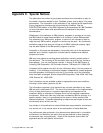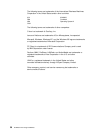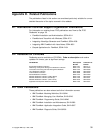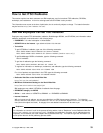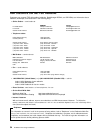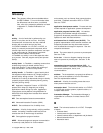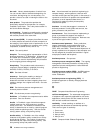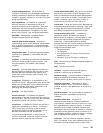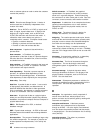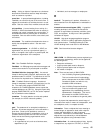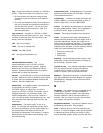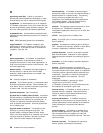
Glossary
Note: This glossary defines terms and abbreviations
for IBM FlowMark. For more information about
the differences and other terms, not defined
here, refer to the respective publication as listed
in Appendix D, “Related Publications” on
page 31.
A
activity. A unit of work that is performed by one
person in one place and at one time. An activity
consumes time and resources and has a defined
duration with an explicit start and end time.
In LOVEM-ProModeler: on a PLOVC or JLOVC, an
activity is a manual process path component, which
receives input from an upstream component, acts upon
it, and sends output to a downstream component.
Activities can be added to manual bands.
In FlowMark: an activity is one of the steps that make
up a process. See also
program activity
and
process
activity
.
activity block. In FlowMark: a modeling construct that
enables the grouping of related activities into a
lower-level diagram. It also enables the modeling of
loops and bundles. See also
activity bundle
.
activity bundle. In FlowMark: a type of activity block
that supports multiple instances of a single program or
process activity during run-time. The number of
instances of an activity is determined during run-time by
a special program activity called the planning activity.
See also
planning activity
.
AIF. Application Integration Feature: a CICS/ESA
product which helps you integrate your existing
applications without writing any code. Applications
communicate across platforms using MQSeries for
MVS/ESA, which keeps them insulated from network
complexities.
AIR. See
assumptions/issues/recommendations
.
AIX. Advanced Interactive Executive (UNIX)
ALOVC. See
architecture line of visibility chart
.
animation. A facility for dynamically verifying workflow
models. Animating a workflow model lets the user
simulate the flow of work through its activities.
API. See
application program interface
.
APPC. Advanced program-to-program communication.
A commonly used protocol for various network
environments, such as Internet, Host communications,
and LANs. FlowMark uses either APPC or TCP/IP.
See also
TCP/IP
.
application development models. Process and data
models required for application systems development.
application program interface (API). An interface
provided by the workflow manager that enables
programs to be started, processes to be controlled, and
operators to work with data containers.
architecture line of visibility chart (ALOVC). The
graphical representation of the essential customer and
enterprise processes and key data needs and their
main characteristics arranged in sequence. See also
enterprise architecture
.
As Is. The current state of a process or process path.
See also
To Be
.
As Is view. A chart or diagram showing the current
state of a process or process path. See also
To Be
view
.
assumptions/issues/recommendations (AIR). In
LOVEM-ProModeler: a business control parameter that
can contain assumptions, issues, and
recommendations.
attribute. The characteristic or property that defines an
entity, such as the attribute of a unit of information.
See also
representative attribute
.
audit trail. A facility for recording events that occur
when process instances are run.
automation band. The horizontal section on a PLOVC
or JLOVC that contains systems, system functions, or
computer data stores.
Automation Manager. The Automation Manager is
responsible for connection of remote clients to OLE
servers.
B
band. The horizontal sections of an LOVC. Examples
of bands:
Customer band
Internal/external organization band
Internal business area or department and job bands
Manual/automation band
Automation band
Copyright IBM Corp. 1996, 1998 37



